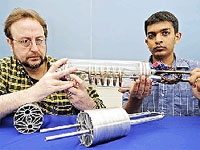Engineers design, build major component for hydrogen cars
25 Feb 2010
Researchers have completed work on a crucial component for an experimental hydrogen storage system for cars, part of efforts to reduce pollution and the use of fossil fuels in transportation.
 |
| Issam Mudawar, at left, a Purdue professor of mechanical engineering, and doctoral student Milan Visaria display their first- and second-generation heat exchangers, a crucial component of a hydrogen storage system for cars. The final design is a coil of stainless steel tubing that fits inside a hydrogen storage "pressure vessel" 4 inches in diameter. Purdue has filed a final patent on the heat exchanger. (Purdue University photo/Andrew Hancock) |
"The system uses a fine metal powder to absorb hydrogen gas under high pressure. When the powder absorbs hydrogen, it becomes a "metal hydride," and the process is called "hydriding." By then decreasing the pressure in the vessel or warming the metal hydride, the hydrogen can be released to drive a fuel cell or engine.
A complication in perfecting the technology, however, is that the hydriding process generates heat, which hinders the absorption process and prevents the hydrogen storage vessel from being filled rapidly, said Issam Mudawar, a Purdue University professor of mechanical engineering who is leading the work with research assistant professor Timothée Pourpoint and doctoral student Milan Visaria.
"If you're driving your hydrogen car, you can't wait an hour at the filling station," Mudawar said. "For this system to be practical, you have to be able to cool the hydride efficiently so that the storage vessel can be filled within five minutes with enough fuel to drive 300 miles."
The researchers have made progress in solving the problem by designing, building and testing the system's heat exchanger and circulating coolant through tubes to remove heat and speed hydrogen storage, Mudawar said.
The engineers filed a final patent in February for the heat exchanger, a coil of stainless steel tubing that fits inside a hydrogen storage "pressure vessel" 4 inches in diameter. Standard automotive coolant is circulated through the tubing.






























